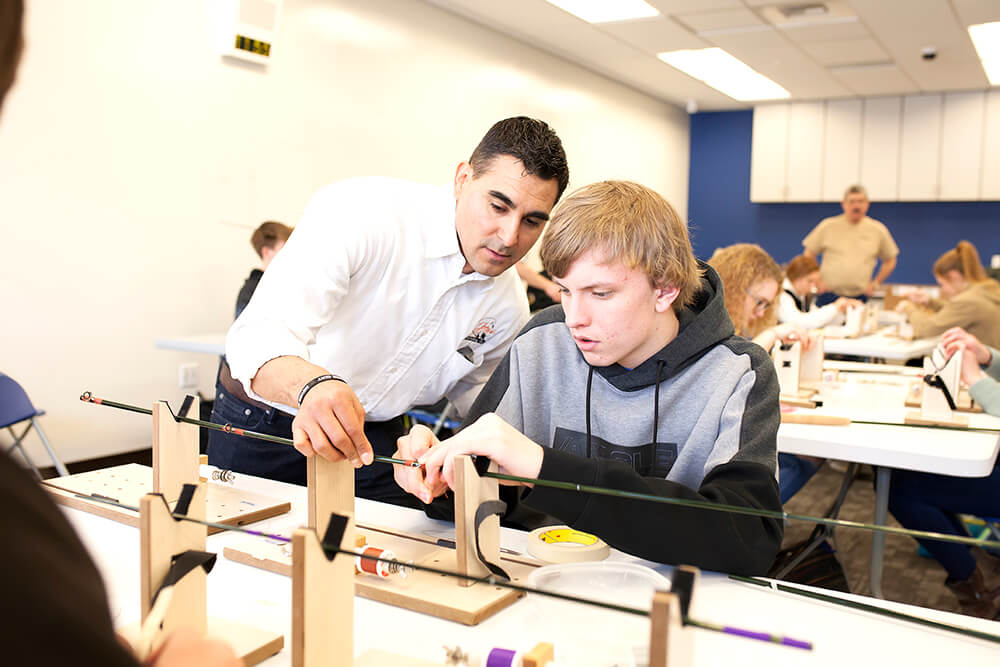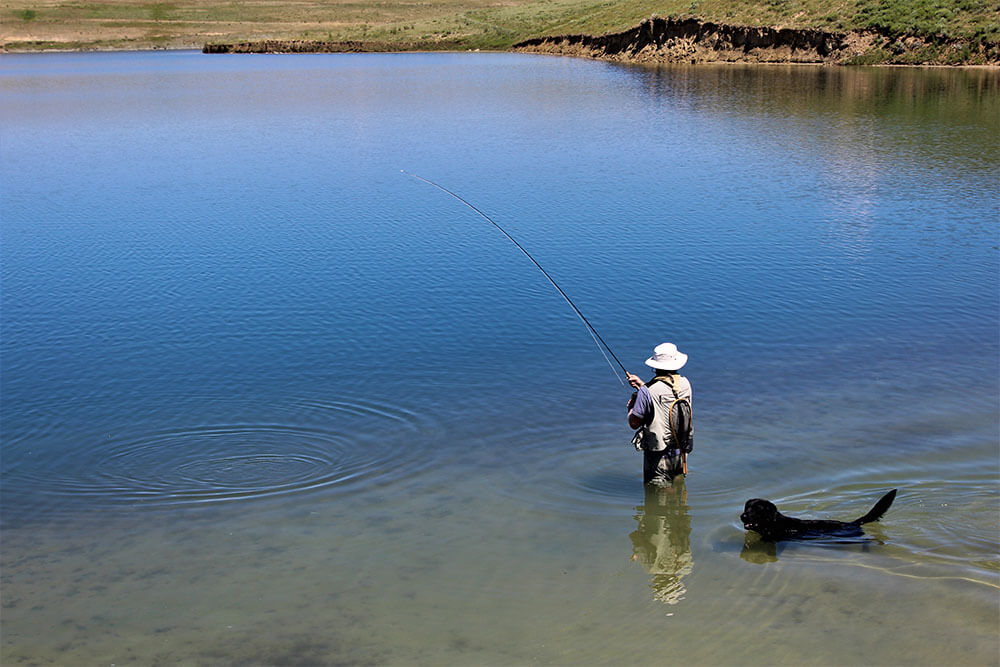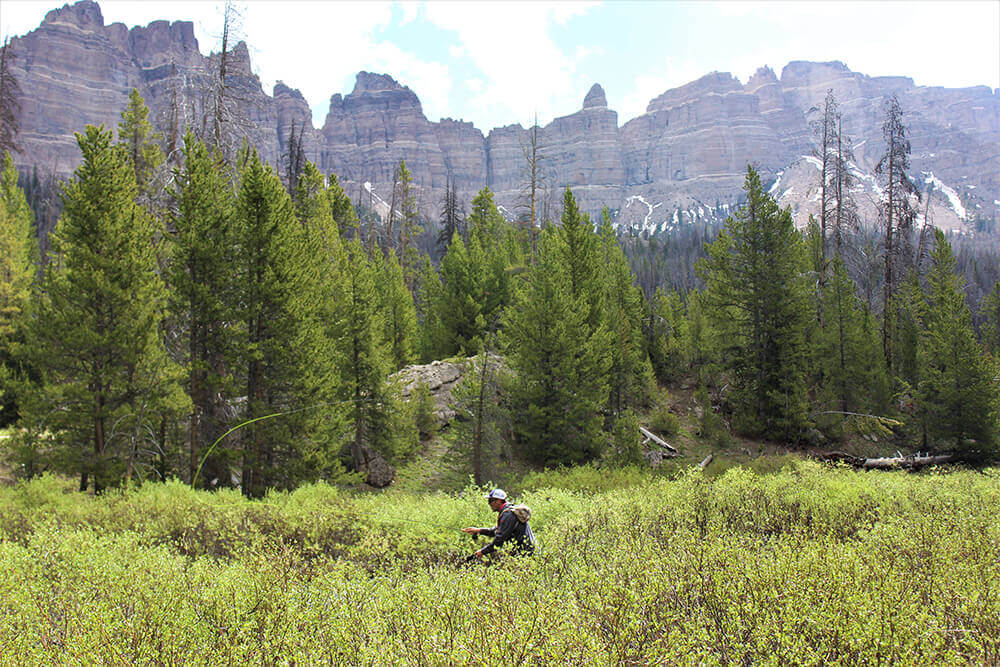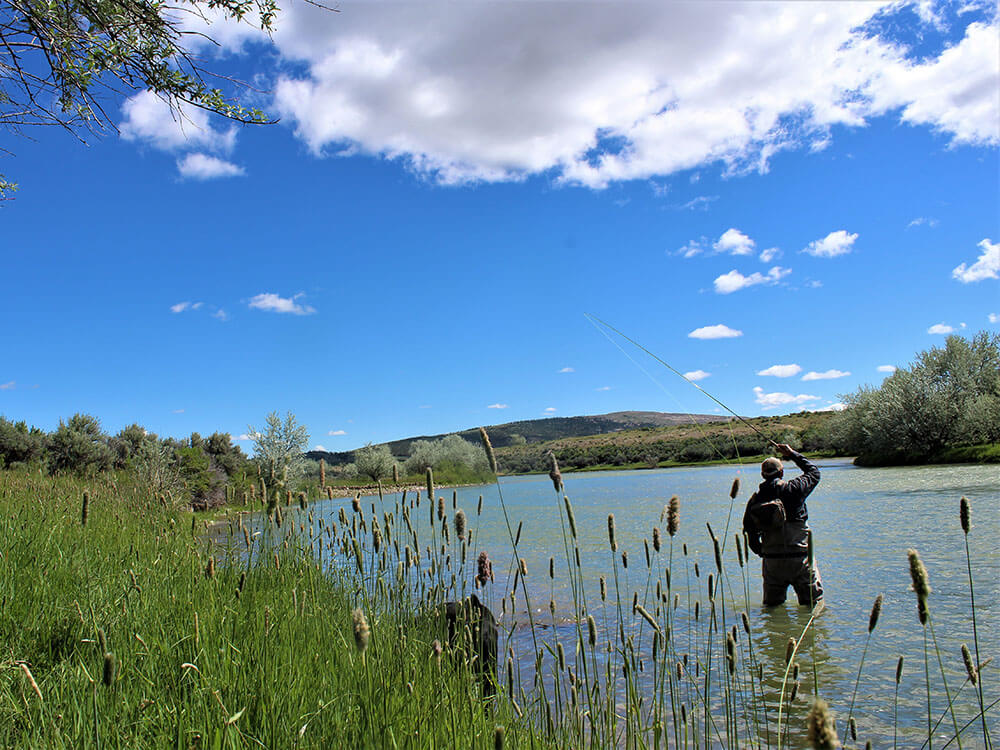Wyoming is a world-class fly-fishing destination. Many first-time anglers who visit the area are intimidated by the size of the state, the unique regulations and the distance between reliable services. I arrived in Wyoming some 25 years ago with no clue. Awkwardly carrying a spinning rod and a fly rod; I wasn’t sure what I wanted to be. Mostly, I was unsuccessful.
Don’t be un-coachable like me. Grab a free copy of the newest regulations and peruse the Game and Fish’s website for articles featuring interesting fishing opportunities, private access, fish stocking schedules and more. Gain a little knowledge and hit the open road. With 27,000 miles of streams, and over 4,000 lakes, the Cowboy State is too big to cover in one effort, but here are four good options for fly fishermen new to the Wyoming scene. These are places to begin, where a little insider knowledge goes a long way, where success is likely, even for the uninitiated.
1. Sheridan: Build Your Own Fly Rod and Put it to Use

Photo Credit: David Zoby
The Vibe
Sheridan is a hip, mountain town with craft breweries and a quaint, walkable downtown area. My favorite restaurant in Wyoming is Frackleton’s on Main Street. Lately, there has been an emergence of new coffee shops, boutiques, and restaurants. The town seems to be changing rapidly, embracing the New West, but retaining much of its original charm in the form of local watering holes such as The Pony, and The Mint. Sheridan is the ultimate Wyoming town with an incredible upside. The Brinton Museum, located on a 620-acre ranch in nearby Big Horn, holds a unique collection of Western Art. There are four terrific golf courses. To meet some locals, hit the Luminous Brew House. Maybe, someone, there is willing to talk trout.
Joey Puetmman, CEO of Joey’s Fly-Fishing Foundation, loves to take kids fishing, so much so, that he has devoted his life to introducing young people to the outdoors. His nonprofit foundation offers year-round classes on rod-building. It’s possible for a visiting family to arrive in Sheridan, enroll in one of Joey’s weekend courses, build their own five-weight rods for a nominal fee, and then fish with them at one of the hot spots just outside of town.
“I run thirteen fly fishing camps each summer—there are ranch kids mingling with city kids—and they come out of it with a fly rod and their own hand-tied flies. You build your own rod, tie your own flies, and you go fishing,” says Joey.
The Fishing
“Sheridan is unique in that it has ten species of trout; and there are warm-water fish, too. The South Tongue is a great place for beginners. It’s open meadows and it’s packed with fish,” says Chaz Davis, manager of the Fly Shop of the Bighorns. Here the knowledgeable staff will help you choose the right flies and what set-ups to use. This is a full-service outfitter; they offer rod and wader rentals and wade trips on private water where you won’t encounter another angler.
By driving the switch-backs up Highway 14, one arrives at Burgess Junction. Anglers can fish Sibley Lake, which teems with brookies. Or they can wader up and fish the North or South Fork of the Tongue River for cutthroats that rise lazily in the summer afternoons. The streambank along Big Willow Creek is a maze of willows and moose paths. But it’s worth it. But the real gem is the nearby Cloud Peak Wilderness, where an angler can hike for days between high mountain lakes and singing creeks.
2. Laramie: A College Town with a Fishing Problem

Photo Credit: David Zoby
The Vibe
This quaint college town boasts an eclectic mix of old-school Wyoming cowboy bars (don’t miss the Buckhorn Saloon) and more modern establishments, like Coal Creek Coffee, that have the characteristics of the changing West. The Sugar Mouse, a gourmet cupcake shop, not only exists in Laramie—there is often a line out the door. In the summertime, most of the students are gone. With grocery stores and reasonably-priced hotels, you can comfortably use Laramie as your home base as you do day trips to hunt for trout.
Afternoon thunderstorms and 85 degrees, Laramie in June is possibly the best weather in the world, or at least that’s what I thought when my biggest question in life was which body of water was I going to fish. As a clerk at the West Laramie Fly Store (circa 1997), I sold licenses and handed out the Game and Fish fishing regulations to visiting anglers. I mopped; I stocked the worm cooler. On my off days, I haunted the Snowy Range.
Jubilee Days —a PRCA event—takes place in early July. This is a true hometown rodeo with nightly street dances and fun events for the whole family. The first week of July coincides with the emergence of caddisflies on the Plains Lakes. Why not attend the rodeo and do a few days fishing for a full Western experience?
And guess what? The West Laramie Fly Store is still in business, nearly thirty years since I was an upstart clerk there. Same dusty trout taxidermy, same glass counters, same drawers of useful fly patterns. There’s perhaps a foolish and enthusiastic clerk such as I was, willing to talk trout, suggest flies, and draw you a rudimentary map.
The Fishing
The Snowy Range, west of Laramie, is laced with public water, both high-mountain lakes and crystal-clear creeks. Dispersed camping abounds, and there are established campgrounds that charge small day fees. From the hamlet of Centennial, one can drive the gravel roads to remote and lightly fished creeks where wild brook trout dominate, but it is not uncommon to catch rainbows and the occasional, wandering brown trout.
The Mullen Fire, which ravaged the area in 2020, left much of the area scorched. But don’t give up on these creeks and lakes. Fires have a regenerative effect on rivers and the complex food webs that support healthy fish populations. Find a creek and put in the miles. In the summer months, you can wet-wade. With a size 16 yellow humpy and a four-weight fly rod, you might even begin to think highly of yourself as one beautiful trout after another rises to your fly. The best bets are Little Brooklyn Lake and Rock Creek.
The Plains Lakes, west of Laramie, are a collection of stocked reservoirs and natural lakes, each with its own personality. Great public access and high fish numbers make these spots popular. You won’t be alone.
Don’t expect to find immediate success with these big fish that feed all year on freshwater shrimp and damselfly larvae. Lake Hattie is famous for giant rainbow trout, but afternoon winds ripping off the Snowy Range can make it a raucous experience better left to the diehards from Laramie. Twin Buttes and Gelatt were always kinder to me on those summer nights when the caddisflies skittered across the surface and the big trout gulped them down with aplomb. I waded, or I used my belly boat to catch a mixed bag of trout, many of which I retained and fried in my rental house.
3. Dubois: Petroglyphs and The Wind River

Photo Credit: David Zoby
The Vibe
New this year, a family can grab a rustic cabin at the Whiskey Mountain Conservation Camp just outside of Dubois and experience some of the best hiking and fishing in the Lower 48. For just $150 per day (lodging and meals included), Wyoming Game and Fish offers a unique 4-day experiences for families wanting to tap into something different. Game and Fish personnel will teach archery, wildlife conservation, canoeing, introduction to fly fishing and other fun, outdoor skills. In a world of $1,000 fly rods, this deal is too great to pass up. Set in the stunning Torrey Valley, this camp was once a working ranch. Now it is available for visitors to enjoy.
The Torrey Valley is also home to many anthropological sites. Petroglyphs are still visible in the lichen-covered rocks along the gravel road. The Dubois Museum offers treks and walking tours of the petroglyphs. They can even arrange private tours on local ranches. On weekends, the Rustic Pine hops with energy.
Dubois is a one-of-a-kind Western town that never sold out. There are no chain restaurants or big box stores here. Home to the National Bighorn Sheep Center and the National Museum of Military Vehicles, this little town grows on you each time you visit.
People are getting tired of me pointing this out, but there are no stoplights in Dubois. You’ll find friendly mom-and-pop shops and fly shops where the people behind the desk will send you in the right direction. Situated at the doorstep of Yellowstone National Park, the fishing out of Dubois is true wilderness fishing. Pick a stream, any stream.
The Fishing
The Wind River and its tributaries would take years to explore with a fly rod. A walking path meanders right through town. Here, pods of trout feed in plain view. By parking at Dubois Town Park, right behind the National Bighorn Sheep Center, an angler can pull on their waders and begin right in town.
A newbie might do better scouting the lesser-known streams where cutthroat and brook trout teem. A dry fly called the Purple Haze will do wonders for your self-esteem. Book a half-day wade trip with guide Jeremy Prine of Dunoir Fishing Adventures. Jeremy is a fourth-generation Wyomingite, who holds a Masters in Education. He is known for his patience with new fly fishermen. Or go it alone on one of the streams in the 35,000-acre Spence & Moriarity Wildlife Habitat area east of town.
4. Casper: Trout City with a Brewery Scene

Photo Credit: David Zoby
The Vibe
Casper has come a long way since I first settled in so many years ago. The windowless, low-ceiling drinking bars have been bulldozed, for better or worse. New establishments—like breweries (a half-dozen and counting) and coffee houses—have replaced the old hangouts. It pains me that so many of our visiting anglers don’t spend more time exploring the new Casper.
The stretch of the North Platte River that runs through town was once full of rebar and tires. Few people fished there. Nowadays, the river sings as it runs through town. It looks like blue-ribbon trout water, which is exactly what it is. Boat ramps have been installed. Guides and recreational anglers save gas money and experience a unique urban fishery as they spend more days floating through town. It’s the biggest thing happening in the local fly-fishing culture. Besides, the scene out at the dam seems as if all the young men in the Denver metropolitan area have arrived on site in high-end waders and sunglasses. Avoid the hype and fish through town.
The second biggest thing happening in Casper is the Ugly Bugs and Crazy Ladies fly fishing clinic for women and girls sponsored each summer by the Ugly Bug Fly Shop. Shop manager and river guide Addie Dees says that fly fishing is often an intimidating and foreign world for women wanting to enter the sport. Her popular 3-day clinic, which culminates with a guided trip with one of the guides, takes an angler through the basics, from choosing a pair of waders to tying flies, to casting. Dees offers three sessions in the summer, two in July and one in August. At only $400 per person, this class is a one-of-a-kind bargain.
The Ugly Bug Fly Shop is in the epicenter of a highly walkable downtown Casper that you will hardly recognize if you haven’t been here in a while. Downtown Casper features art galleries, unique boutiques, and brewhouses complete with an emerging music scene. Check out the Backwards Distillery for craft cocktails. I take my cortado at The Bourgeois Pig, or I go without.
The Fishing
Most of the fly fishermen congregated around the dam at Grey Reef, some 29 miles from town. But an annual river flush, solid conservation practices, and a lot of hard work and pride by local conservation groups and businesses have created fishing opportunities that run right through the middle of downtown. The Platte River Revival is a multi-year, 23 million dollar project to help democratize and restore the once grossly polluted North Platte. Birds, mammals, and riparian vegetation are all part of the plan. But so are trout.
Anglers can do well wading in the Morad Park section right in town. Or they can drive to other public areas such as the Speas Hatchery section, the Sechrist section, or the dusty, two-tracks that wind through an area known as Trappers Route. These public areas allow anglers to wade sections of world-class trout water without the crowds associated with the Grey Reef section.
Most likely you will be using the typical nymphing setup: a nine-foot 3X leader, an indicator, and two wet flies. You must get your flies down if you want to have success on the North Platte, so a baggy of split-shot is necessary. It’s not heroic to fish a pine squirrel leech and a rock worm, but that’s the drill if you want to have success.
The more adventurous angler might drive to the famous Miracle Mile below Kortes Dam. This blue-ribbon section supports a healthy population of “football” rainbow trout but is most known for its brown trout that can grow to epic size.
Support Local Shops & Guides
Show our fly shops and guides some love. Like so many fly shops all over Wyoming, the folks behind the counter are there to help. They are professionals who love to talk trout. Maybe they won’t give up their secret spot, but they won’t steer you wrong. They even have copies of the fishing regulations with maps and all kinds of good information. Don’t be like me. Take their advice and save yourself the years it takes to know where to begin. Be coachable. And if they draw you a little map, tuck it somewhere safe.